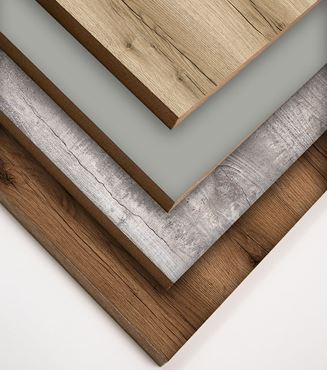Veneer vs Laminate: The Main Differences for Home Interior
High-quality wooden finishes have been valued at all times for their durability, environmental friendliness, and attractive appearance. But products made from natural wood have a big minus such as high cost. Veneer and laminate have become affordable replacements for natural wood. Let’s analyze the main difference between laminates and veneers and the characteristics of the materials to decide which one is better for a home interior.
What is a Veneer Finish?
Talking about the difference between laminate and veneer, we should mention that the natural veneer finish is a decorated wood sheet that has been cut from solid wood and retained the grain pattern. It is sold in the form of plates with a thickness of up to 0,5-1 inch. This finishing material is made on special woodworking machines. The main feature of natural veneer is the pronounced texture of the real wood pattern. Also, you can compare veneers with solid wood when you touch the surface. PVC film usually reminds everyone of the usual plastic. Veneer finishes are usually sold in a dried and sanded form with a protective coating.
Veneer Benefits
Veneer wood laminate has many advantageous characteristics that make it a popular choice among consumers. This material rarely deteriorates from the influence of negative environmental factors, it is not prone to cracking. Let’s list the main veneer benefits:
- affordable price;
- attractive appearance and aesthetics;
- environmental safety (veneer contains about 75% natural wood, so it can be safely used in the interior design);
- a wide range of shades;
- high strength and reliability;
- long service life.
If the veneer laminates have been used for a long time, you may need to restore them. Furniture and door structures that are finished with this material are cheaper but at the same time, they are characterized by special practicality. The main disadvantage of the material is that it can deteriorate under moisture. Also, experts advise protecting natural veneers from scratches.
What is Laminate Finish?
Laminate is a versatile material, made from pressed sawdust with formaldehyde resin. The plate is formed at high temperatures. The color coating of the laminated chipboard is a melamine film (paper impregnated with resin) coated with resistant varnish. The material is used for interior decoration and the manufacture of decorative elements and furniture.
Laminate Benefits
Decorative laminates have long and firmly occupied their niche, as they have significant competitive advantages. For example:
- Laminate does not require additional processing after installation. The material doesn’t need to be cycled, sanded, or varnished.
- Laminate is resistant to fading in the sun and impervious to dirt. Mud stains are easily removed with acetone, which will also not harm the board.
- The floor covering withstands long-term loads and abrasion.
- Ease of cleaning makes it a leader among popular finishing materials.
- Laminate is heat-resistant. The material doesn’t burn and it conducts temperature well.
Existing myths about its non-environmental friendliness have not been confirmed. Laminate does not emit harmful substances into the atmosphere, despite the not entirely natural structure.
Veneer vs Laminate: What to Choose
When choosing a material for interior decoration, the question often becomes what to choose: veneer or laminate. To decide, it is necessary to generalize and take into account the main difference between veneer and laminate.
- The laminate usually costs less than veneer, but the final cost depends on the brand. The price of veneer differs depending on the type of wood and can sometimes be very high if valuable wood species were used as raw materials.
- When it comes to laminate vs veneer maintenance the first material wins. It is waterproof and scratch resistant, so it will retain its good appearance for many years. To maintain the veneer, you will have to polish it periodically.
- Variety of shades. If you can’t choose between laminate and veneer, notice that laminate comes in a wide variety of colors to suit any interior. Since veneer is a natural material, it is available in a limited number of shades, which depend on the type of wood.
- The service life of laminate is much higher than that of veneer due to its durability and reliability. Laminate resists scratches well, unlike veneer. Therefore, it is very often chosen for interior decoration.
- Resistant to heat and moisture. The laminate has good resistance to high temperatures and moisture. But under the constant influence of negative factors, furniture with a laminate will be damaged in time. And veneer furniture can also fade in the sun, so you must protect it from sunlight.
Considering all the features, advantages, and disadvantages of veneer sheets vs laminate, we can conclude that the choice of material should be made based on the practicality of its use in a particular area of room designs. A laminate finish is better to choose for modular kitchen cabinets, wardrobe designs, doors, and other furniture that is in constant use. The veneer has an attractive appearance, completely repeating the pattern of natural wood. Therefore, the material can be a good choice for finishing furniture in bedroom and living room designs, which plays an aesthetic role in interior designs and is not often used.
Check Next >https://www.neoadviser.com/make-a-safer-work-environment/

